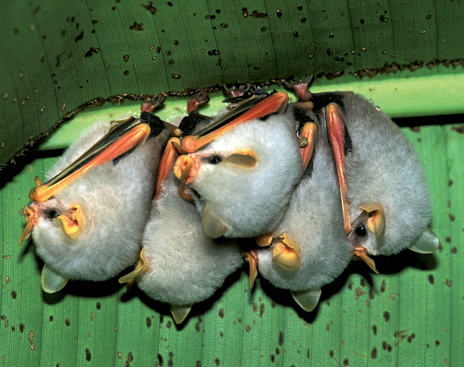There are more than 1,100 species of bats. It’s not unusual to spy a few of the furry creatures hanging from rafters or swooping around at night. Despite vampire folklore, bats are not out to suck your blood and most are fruit eaters. In fact only three species sustain themselves with blood.
Bats have forelimbs which form webbed wings making them the only mammal naturally capable of true and sustained flight. They do not flap their entire forelimbs, as birds do, but instead flap their digits, which are long and covered with a thin membrane. Most bats are nocturnal and are active at twilight. Some pass into torpor in cold weather, rousing and feeding when warm weather allows for insects to be active. Others retreat to caves for winter and hibernate for six months. They rarely fly in rain, as it interferes with their echolocation, and they are unable to locate their food.
Many lowland open areas have small bats swooping around at dusk, catching insects. Larger bats eat fish, fruit or small animals, and others drink flower nectar or animal blood. Exactly where they might be found depends on the species of bat, the time of year and what they are doing. Some of the UK’s older churches have seen generations of bats return faithfully to the same roost (nest) year after year. During the day bats roost in hollow trees or under wooden roofs, tunnels and bridges. I have seen several white-lined sac-winged bats in buildings in Santa Rosa National Park on the Nicoya peninsula in Costa Rica. These small social bats roost in colonies of 5 to 50 individuals and have dark fur with two long wavy white lines on the back.
One of the largest bats in Central America is the fishing bulldog bat which has a 60cm wingspan. Most of this is skin and bones, so adults weigh under 90g. They fish in both salt and fresh water, and the Tortuguero canals in Costa Rica are ideal for watching them grab large insects and small fish with their sharply clawed enlarged feet. Another large bat, the Jamaican fruit bat feeds on fruits of large trees, especially figs, which they grab on the wing and take to a feeding roost for consumption. These bats won’t feed during the brightest full-moon nights for fear of owls. Other predators of bats include bat hawks, bat falcons and even spiders. All three species of vampire bats are restricted to the Neotropics and are found in Costa Rica. Unusual among bats, these bats are agile on the ground and can hop, run, and crawl toward their prey, which consists of birds and animals. They actually prefer to bite the toes of their sleeping human victims rather than the neck.
The Galápagos bat is found on the islands of Santa Cruz and San Cristobal. It roosts in mangroves or dense scrub during the daytime. The tube-lipped nectar bat of Ecuador and the banana bat that lives only on the Pacific coast of Mexico both have extraordinarily long tongues for this exact reason. The tube-lipped nectar bat’s tongue is more than one and a half times the length of its body! The Brazilian free-tailed bat has been recognised as providing an important pest management service in cotton farming.
Bats are incredibly useful in controlling insects and pollinating flowers. Over 500 plant species rely on bats to pollinate their flowers. They also have an extremely important role to play in seed dispersal which can help with regrowth after a forest clearance. Most people think of bats as being black, but they come in a variety of browns, grays, yellows and reds. Sadly, many bat species around the world are vunerable or endangered due to factors such as loss of habitat, diminished food supply, disease and hunting of bats. The social structure of bats varies, with some bats leading solitary lives and others living in caves colonized by more than a million bats. Studies also show bats make all kinds of sounds to communicate with each other.
Our office recently had a flying visit from a bat which caused quite a stir!
Since 1991 the Bat Conservation Trust has run a diverse range of projects to conserve bat populations www.bats.org.uk
Lloyd Boutcher,
Director Sunvil Traveller
